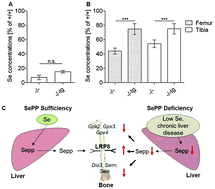Selenoprotein P is the essential selenium transporter for bones†
Abstract
Selenium (Se) plays an important role in bone physiology as best reflected by Kashin–Beck disease, an endemic Se-dependent osteoarthritis. Bone development is delayed in children with mutations in SECIS binding protein 2 (SBP2), a central factor for selenoprotein biosynthesis. Circulating selenoprotein P (SePP) is positively associated with bone turnover in humans, yet its function for bone homeostasis is not known. We have analysed murine models of altered Se metabolism. Most of the known selenoprotein genes and factors needed for selenoprotein biosynthesis are expressed in bones. Bone Se is not associated with the mineral but exclusively with the organic matrix. Genetic ablation of Sepp-expression causes a drastic decline in serum (25-fold) but only a mild reduction in bone (2.5-fold) Se concentrations. Cell-specific expression of a SePP transgene in hepatocytes efficiently restores bone Se levels in Sepp-knockout mice. Of the two known SePP receptors, Lrp8 was detected in bones while Lrp2 was absent. Interestingly, Lrp8 mRNA concentrations were strongly increased in bones of Sepp-knockout mice likely in order to counteract the developing Se deficiency. Our data highlight SePP as the essential Se transporter to bones, and suggest a novel feedback mechanism for preferential uptake of Se in Se-deprived bones, thereby contributing to our understanding of hepatic osteodystrophy and the consistent bone phenotype observed in subjects with inherited selenoprotein biosynthesis mutations.


 Please wait while we load your content...
Please wait while we load your content...